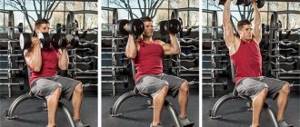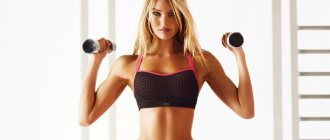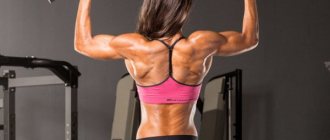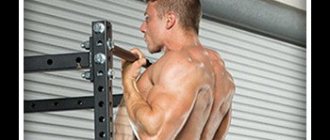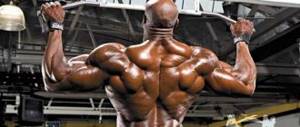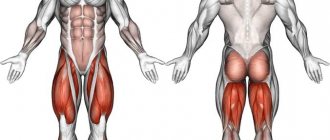Hit the horizontal bars in the morning and you’ll be strong for the rest of your life!
Backyard sports have never lost their relevance, although after the collapse of the USSR they went out of fashion for some time - the old outdoor playgrounds fell out of order in a short time and were unsuitable for training.
In recent years, there has been a pleasant trend - society is gradually returning to a healthy lifestyle. New backyard exercise machines, parallel bars and various horizontal bars began to appear everywhere. Young people are re-learning street sports, learning the basics of the correct training regimen for turnstile men.
Street athlete - agile turnstile man
The artificial origin of the term turnik-men does not negate the need to correctly draw up a training program on the horizontal bars. Any person who performs exercises on outdoor horizontal bars can be considered a turnstile man. The simplest and most boring exercise is the usual pull-up, known to everyone from school. More interesting and difficult variations are inversions, sun raises, one-arm pull-ups and other pirouettes.
Unlike professional gymnasts, the training program is distinguished by a fairly gentle regime. Performing exercises on outdoor horizontal bars is designed not so much for high achievements as for strengthening the body and increasing physical strength.
Recommendations for classes
Let's listen to the advice of professionals who went from doing zero pull-ups to setting records and answer frequently asked questions.
What to do if you can never do a pull-up on the bar?
Use regular dumbbell and machine exercises to build muscle mass. But don’t forget that the key to muscle growth is proper nutrition.
If you are overweight, you will have to lose weight first. By creating a calorie deficit in your diet.
Use half-range pull-ups.
Secrets of pull-ups or how to do more pull-ups
As Brett Stewart, author of the book “50 Pull-Ups in 7 Weeks,” says: “You need to strictly follow the technique when doing pull-ups!” Only in this case can you properly load those muscles that will help you achieve your goal.
The duration of classes should be no more than 40 minutes per day.
Reduce the load during training if you feel that you do not have time to recover.
Restrictions for playing yard sports
Anyone can become a turnstile maker, regardless of age and gender. The most impressive results are demonstrated by athletes who, from childhood (4-5 years of age), constantly perform a set of exercises on horizontal bars.
For girls, due to the physiological characteristics of the body (muscle structure, thinner bones), it is much more difficult to achieve impressive results. The optimal age for starting training for guys is 15-16 years old, although it is not too late to start training at 25-30 years old, and old age (up to 60) is not a barrier. The main thing is to correctly create a training program and not overload the body with unnecessary stress.
People who have various problems with the spine (curvatures, injuries), as well as those suffering from underweight or overweight, should approach exercises with caution. Classes are strictly contraindicated in case of muscle dystrophy, serious problems with tendons and joints.
But how effective are these pull-ups?
Many people claim that changing your grip helps you work the muscle from different angles. Some people say that by changing their grip, they work, for example, the lower pectoral muscles, the posterior head of the deltoid muscle, etc. Let's take a closer look at this issue!
For example, let's take pull-ups with a wide grip behind the head. This exercise is very popular in sports halls, since many bodybuilders consider it almost a panacea for the growth of the latissimus dorsi muscles.
Often you have to watch guys on the court who try to grab the crossbar wider, citing the fact that this way the lat works better. Many people do not even suspect that such pull-ups are traumatic for the shoulder joints! And there can’t even be any talk about fully pumping up the back muscles!
Why?
When doing pull-ups with a wide grip behind the head, the amplitude of movement decreases, as a result of which the back muscles do not contract completely, which leads to their poor quality development. In order to qualitatively work out one or another muscle group, you need to select an exercise (in our case, a grip), at the amplitude of which the muscle group being trained will completely contract.
Remember once and for all! The muscle contracts completely, or does not contract at all! So now it’s up to you to choose and think about which path is more adequate in this matter!
But what about close-grip pull-ups?
The Internet is replete with information on how to do pull-ups! As I said above: “There are many variations!”
Let's look at pull-ups with a narrow pronated (straight) grip and compare them with classic pull-ups. Do you think there is a difference? There is practically no difference. In both the first and second cases, the muscles work (contract) the same way, and the emphasis of the load change is 1-5%. Do you think you can feel such a difference?
For starters, I want to quote Alexey Ozherelye. Despite the fact that he talks about pumping up the abdominal muscles, the essence of the issue does not change. Very often in the gym you hear from trainers that you can separately pump up the lower part of the abs and the upper part.
There are no exercises for only part of a certain muscle, it doesn’t matter if it’s the abdominal muscles or any other
A muscle always works as a whole, it cannot work in parts. Either it contracts or relaxes. Everything else is a “myth about the afterlife,” as the well-known character from “The 12 Chairs” used to say.
If we approach the issue formally, we can change the emphasis of the load (but not the entire load) on a part of the muscle, but these changes are within 1-3%. Do you think you can feel such a difference?
And instead of a conclusion!
Use a classic grip for both pronated (straight) and supinated (reverse) pull-ups! In the first case, grab the bar slightly wider than shoulder-width apart, in the second case, shoulder-width apart! It is with this positioning of the hands that the trained muscles contract completely! And for quality work this is very important!
Train correctly! Good luck with your pull-ups
Still have questions? Visit our forum.
Bicep pull-ups.
Grab the bar with a reverse grip (palms facing you), with a narrow grip, hands 5 - 15 centimeters from each other. Pull yourself to a position with your chin above the bar.
Lower yourself down until your elbows are in front of your eyes. Then up again. If you go below the elbow bends, the latissimus muscles take over the load. Biceps work less.
In this way, we create conditions for the highest quality work of the biceps, but one should not think that the latissimus muscles work very weakly. They are also good at this exercise.
Since it is easier to do pull-ups with a reverse grip, you need to take a pull-up belt and train with weights. But don't force the workout right away. To avoid damaging anything, do pull-ups without weights for the first 2 months, little by little. Let your muscles get used to the new exercise.
Muscle recovery.
And once again I want to remind you, do not train in pull-ups every day. The muscles of the back and biceps get tired from training just as much as other muscles. And in order to pull themselves up more than last time, they need rest. Only bodybuilders on steroids can do pull-ups every day. A pure athlete, and we are talking about them, needs to rest for 5 days. During this time, the muscles will recover and hypertrophy (increase in size). And they will be able to pull themselves up better than before. See muscle recovery.
The capture methods are as follows:
- straight or overhand grip - the athlete’s palms are directed in the direction opposite to his face;
- reverse or bottom grip - the crossbar is grabbed from below and the palms look into the face of the person pulling up;
- neutral or parallel grip - the hands are turned inward and the palms are facing each other.
Effective turnstile training program
The training program depends on the physical fitness of the athlete. A person who goes outside to play sports for the first time in many years will not be able to cope with complex exercises. And a fit man who needs additional exercise will be bored with monotonous actions. The better the physical shape, the more intense and varied the classes can be.
Exercises on horizontal bars include four stages:
- warm-up (warming up muscles, breathing exercises, toning the whole body);
- strength training (strengthening the back and arms, pull-ups on the uneven bars, doing the backstretch);
- performing technical elements (“sun”, “scrolling”, “endo”, all kinds of revolutions);
- completion of the workout (stretching, relaxation exercises).
The effectiveness of training directly depends on the quality of each stage:
- A lazy athlete who refuses to warm up and decides to immediately show off his prowess risks serious injury due to unwarmed muscles and decreased concentration.
- Without strength training, it is impossible to either strengthen muscles or learn to control them correctly. This means that the next stage (hone the technique) will be a completely pointless exercise - if the physical strength is not enough for a basic pull-up, where will they come from for the “sun”?
- Technique development is necessary to diversify the training process. Doing the same exercises over and over is incredibly boring! And to increase the effectiveness of training, it is necessary to use all muscle groups, which will only be possible when performing complex technical exercises.
- Correct completion of the workout allows you to get rid of excess tension in the muscles and return the body to a relaxed state. Strength exercises must be combined with yoga, stretching, meditation - without this, the body quickly wears out and, instead of improving health, brings unnecessary problems.
How to do it right
Drop Set is a technique used in strength training and bodybuilding. In the first phase of the exercise, the heaviest weight is used to gradually lower it. When doing a pull-up, the athlete clamps and holds a heavy dumbbell or kettlebell between his legs. This technique is aimed at maximizing muscle growth.
The following approaches to the horizontal bar are used in it:
- The first is to use the heaviest weight, for example 13–13.5 kg, with which the athlete gets tired after 4–6 repetitions and stops performing.
- Second - the weight is reduced by 2.5 kg, after which you need to do 8-10 pull-ups.
- Third - the weight is reduced by another two and a half kilos and 10-12 repetitions are done.
- The fourth is another weight reduction of 2.5 kg and another 12–15 repetitions.
- Fifth - here the weight is reduced at the discretion of the athlete (options: 2.5 kg or 5 kg), 15-20 pull-ups are performed. In the fifth approach, it is not necessary to adhere to the specified number of repetitions, but can be performed as many as the athlete is able to do.
There are many different types of pull-ups. You can place your hands close to each other on the bar, or create a wider grip. The wider the distance between the palms, the more the back muscles will work. For those who want a V-shaped back, it's best to work with a wide grip on each set.
We recommend learning how to properly perform negative pull-ups, as well as wide, parallel and reverse grip pull-ups.
The way you grip the bar will also affect which muscles are used.
Gripping with the palms facing away from the athlete is a pull-up involving the back muscles, and performing with the palms facing the person doing the exercise involves the biceps. Neither of these methods is better than the other, they are simply two different exercises that use a slightly different way to move different muscle groups when lifting body weight.
Important! Control your movements so that they are slow and smooth throughout the session.
Let's look directly at the technique of pull-ups on the horizontal bar; it can be performed both with the use of weights of various weights and configurations, and without them:
- Grab the bar with your hands, palms forward, with the space between your palms slightly wider than your shoulder width.
- Keep your legs slightly bent, kneecaps as close as possible.
- Concentrate on your back muscles and feel them contract as your arms lift your body up. There is no need to tuck your chin over the bar.
- When you pull yourself up, fix your position for a few seconds at the highest point of the lift, pressing your stomach against the bar.
- Pull yourself up slowly, mentally, slowly, counting to three, then freeze, squeezing your back muscles, then also slowly lower yourself to the count of three.
- Between reps, hang slightly from the bar, looking down and relaxing to allow your back muscles to move away from your shoulder blades and return to their rightful place.
As with other exercises, there are some errors in the pull-up that need to be addressed to make it safe and effective, including:
- Partial range of motion - the full length of the muscle needs to be developed, so always work from full extension at the elbow until your chin passes the bar.
- Lack of control when lowering - lowering the body down is as important as pulling it up, so after lifting the athlete should not allow the body to fall sharply down, so as not to injure the shoulder girdle.
- Jerky movements - do not use additional jerks, jumps or push-ups to pull yourself up, this can lead to strain in the muscles of the shoulders and back.
Did you know? Strength training equipment appeared in Europe and America in the sixties of the last century, but their demand increased in the 1970s, along with the fashion for bodybuilding and the popularity of bodybuilder Arnold Schwarzenegger.
Basic exercises on horizontal bars
The main stages of turnstile training are a block of technical improvement exercises and a block of strength training exercises. Warm-up and proper completion of training are a necessary component in any sport.
Strength exercises
Beginners should start training on horizontal bars with strength exercises. The load is formed individually, depending on the neglect of the body.
With frail muscles, obvious shortness of breath and a long absence of physical activity, classes begin with a “gentle” training mode: regular pull-ups and push-ups. The traditional scheme is to perform each exercise 3 sets of 5-10 times. Then move on to the jump rope, pumping up the legs, strengthening the abs and gradually completing the workout with muscle stretching and yoga. With each day of training, the number of exercises increases, the technique becomes more complicated.
Technical prowess
Turnikman trains techniques traditional for professional gymnasts. True, complex and traumatic exercises are excluded, which can only be performed in a specially equipped room under the supervision of an experienced trainer.
They begin classes by performing pull-ups on their hands with an inversion, then move on to the “sun” familiar from childhood. After mastering the basic techniques, the technique becomes more complicated and complex turns become available to the turnstile man - “endo”, “stallder”, “Russian-Czech turns”.
Friday
After yesterday's load, it would be logical to conduct an easy lesson, which is what we will do.
- Let's start with standard push-ups, arms width - shoulders;
- The next push-ups are essentially the same, only, firstly, already on the fists, and secondly, the elbows should not leave the body during the process;
- The third push-ups for today are narrow. Place your palms on top of each other so that they form something like a rhombus;
- Press – we perform crunches, but only with torso turns to the sides to pump up the oblique abdominal muscles;
- We also raise our legs while lying down - the lower abs also require attention;
- We end the week with simple crunches all the way.
Alexander Bely
Basic rules for training on horizontal bars
Horizontal bars are available to everyone, but you shouldn’t be overzealous. You are not on the podium and the main task is not to amaze the admiring audience, but to strengthen your muscles and create a beautiful, sculpted body.
Safety rules on horizontal bars:
- Use a comfortable grip. Before training, hands are treated with sand or talcum powder. In the cold season, it is recommended to use special gloves that are not too slippery.
- Distribute your weight correctly. For most exercises, a basic position is suitable: legs crossed and bent at an angle of 90 degrees, back straight, arms comfortably clasping the horizontal bar.
- Try to move smoothly. Sharp, rough movements are unacceptable. When doing pull-ups, do not engage your pelvis (sudden hip movements can lead to arm injury). Systematically strengthen the muscles of your arms and back by gradually increasing the load.
- Start simple. Becoming a pro in two days is an unrealistic task. Move on to complex exercises only after you have completely mastered the simple ones.
Exercise technique
You can perform pull-ups on the horizontal bar either daily or a couple of times a week. There is no need to perform them to the point of exhaustion; a load of 70 percent is optimal. Performing 7-8 pull-ups helps develop muscle strength, and subsequent repetitions of the exercise are aimed at developing endurance. When and how to increase the number of pull-ups on the horizontal bar is decided individually during the training process.
Before you start doing pull-ups, it’s a good idea to do some warm-up exercises, such as push-ups. The pull-up program depends on what you want to achieve: develop arm strength or increase muscle mass.
- Hang on the horizontal bar, choosing the width and grip method you need.
- Make an upward movement while exhaling. The movement should be carried out due to the movement of the shoulder blades. There is no need to try to pull yourself up with the strength of your biceps, since the latissimus dorsi is a much stronger muscle group. The same applies to various jerking movements of the pelvis and legs - this is not permissible in the classic version of pull-ups. Try to focus on the position of your elbows. You should “press” them down as you lift your body - this will maximize the load on the latissimus dorsi muscles.
- The movement is best performed in full amplitude. At the top point, the chin should be located above the level of the horizontal bar, and the elbows should be practically pressed against the body.
- Slowly lower yourself down while inhaling. The descent in time must be equal to the ascent. At the bottom point, fully straighten your arms and relax your back muscles. pause for one second, then perform another repetition.
